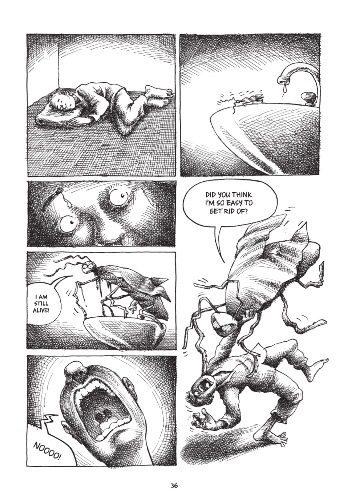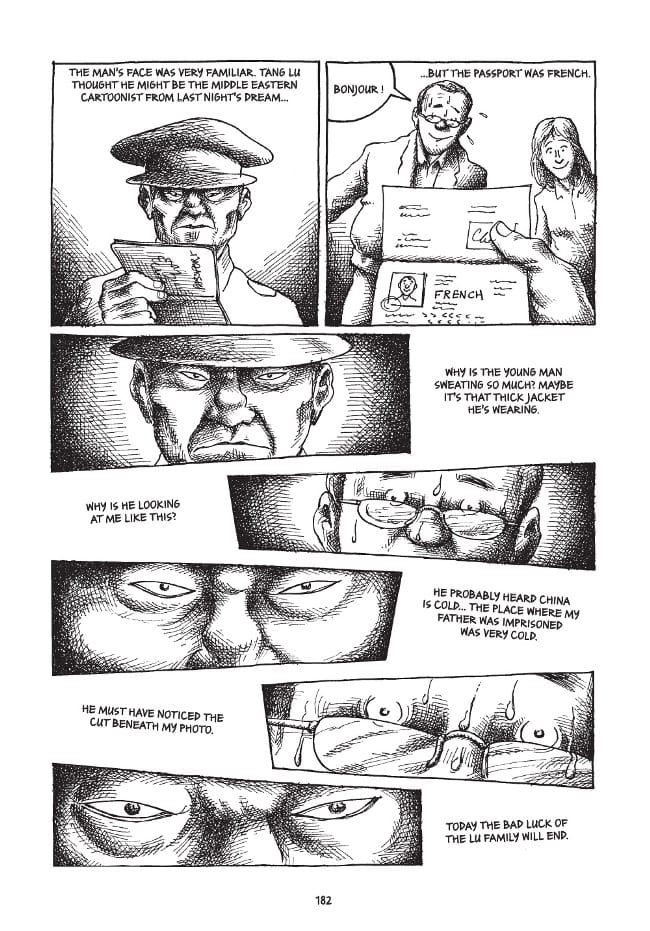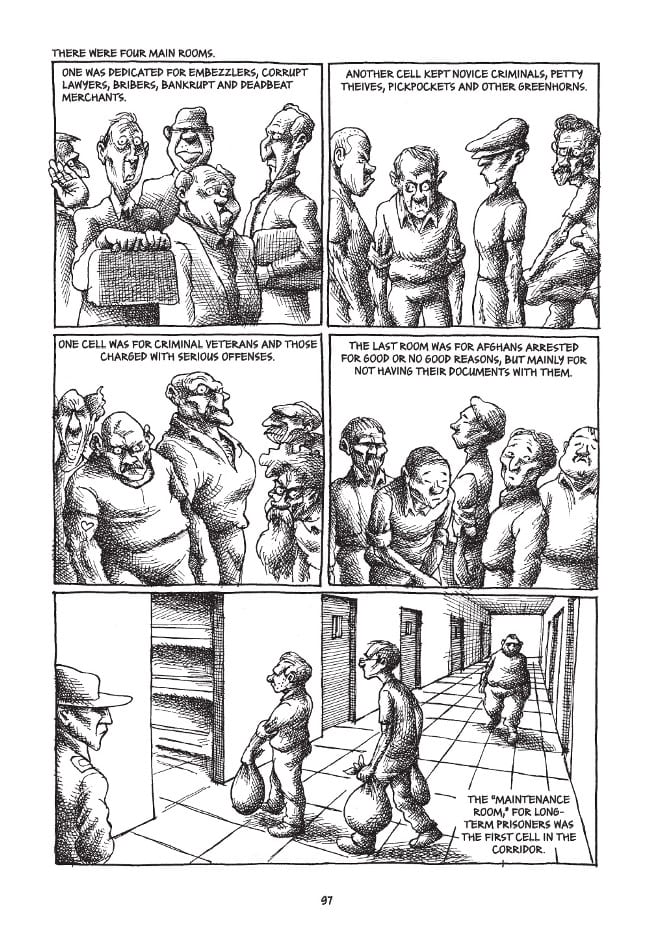In 2006, protests broke out among Iran’s Azeri peoples based on a perceived slight in one of Mana Neyestani’s newspaper cartoons. The Iranian government’s response to the situation involved a series of interrogations and imprisonments for Neyestani. An Iranian Metamorphosis (Une Métamorphose Iranienne in its original, overseas edition) is Neyestani’s first book-length comics narrative and a memoir of his time as a captive and later a refugee. The work reads like that of a cartoonist unsure which tools to use in the reconstruction of his story but willing to try all sorts of things. It is eclectic and sometimes frustrating.
An Iranian Metamorphosis features many plot-level details that bring to life the prison experience: a guard consenting to pass along soccer scores; the onset of psychological isolation even while sharing a cell; the workings of an intra-prison black market. Neyestani even gambles with his readers’ sympathies to portray the range of his ordeals: A particularly uncomfortable scene shows him becoming a sort-of informant, as he provides benign information about fellow cartoonists that (we understand) Iranian intelligence officials could still distort for their purposes.
 Neyestani’s compositions don’t always capture these moments in a memorable fashion. In fact, Neyestani’s narration often contributes more to the comic’s sense of place than his renderings of his younger self’s surroundings, which sometimes lack atmosphere or even basic in-panel information. The pages of An Iranian Metamorphosis are busy with crosshatching, but this hatching is a poor substitute for more intentionally deployed linework. Page 29 of the book introduces Neyestani’s chief tormentor, “Maleki.” Here, Neyestani depicts the exterior and the interior of Maleki’s office building with similar patches of crosshatching—a failure to differentiate between spaces that undercuts the impact of Maleki’s first appearance. On page 51, Neyestani cuts between an indoor scene for which his younger self is present and an outdoor protest scene that the younger Neyestani imagines. Here also, Neyestani renders both environments so sparsely—the hatching and nothing else—that readers don’t experience any charge from the juxtaposition.
Neyestani’s compositions don’t always capture these moments in a memorable fashion. In fact, Neyestani’s narration often contributes more to the comic’s sense of place than his renderings of his younger self’s surroundings, which sometimes lack atmosphere or even basic in-panel information. The pages of An Iranian Metamorphosis are busy with crosshatching, but this hatching is a poor substitute for more intentionally deployed linework. Page 29 of the book introduces Neyestani’s chief tormentor, “Maleki.” Here, Neyestani depicts the exterior and the interior of Maleki’s office building with similar patches of crosshatching—a failure to differentiate between spaces that undercuts the impact of Maleki’s first appearance. On page 51, Neyestani cuts between an indoor scene for which his younger self is present and an outdoor protest scene that the younger Neyestani imagines. Here also, Neyestani renders both environments so sparsely—the hatching and nothing else—that readers don’t experience any charge from the juxtaposition.
The pages in which Neyestani crosshatches the least are actually some of the book’s strongest. During scenes that recreate the sensation of walking through prison while blindfolded, Neyestani trades hatched backgrounds for spot blacks, a move that conveys his younger self’s insecurity and shows off Neyestan’s talent for drawing human forms. He also has a talent for expressive faces, and in pages like the one below, he uses that skill—and a deliberate panel arrangement—to create rhythm and tension:
Neyestani’s obvious pleasure in drawing different types of bodies enlivens his memoir in a way his backgrounds do not. (If he were half as interested in drawing walls and floors, this would be a more immersive book.) On a page in which he illustrates different groupings of inmates, for example, his usage of caricature intensifies the reader’s impression of the prison as a real place with real inhabitants:
One of Neyestani’s boldest attempts to convey the feeling of sudden imprisonment comes in the form of his book’s title and its nod to Franz Kafka’s short story. Like Gregor Samsa before him, Mana Neyestani found himself plunged into a world of confusion. While Samsa became an insect (a beetle, if we trust Nabokov), Neyestani became a prisoner—a comparison Neyestani overcomplicates by also depicting himself as the victim of a malicious cockroach.
 Neyestani drew the scrutiny of the Iranian government after drawing a cartoon that members of Iran’s Azeri population believe compared them to cockroaches. The overgrown roach that taunts Neyestani embodies this controversy, taking a form that also captures the persistence of Neyestani’s tormentors. In other words, this choice works fine in isolation. But couple the talking cockroach with Neyestani’s Kafka reference, and An Iranian Metamorphosis suffers from a thematic muddle. The book draws parallels between its protagonist and Gregor Samsa while also positioning an insect character (an insect motif, at least) against its protagonist. It’s distracting, basically, and disappointing; some readers will be tempted to imagine a book in which Neyestani had committed to one approach or the other.
Neyestani drew the scrutiny of the Iranian government after drawing a cartoon that members of Iran’s Azeri population believe compared them to cockroaches. The overgrown roach that taunts Neyestani embodies this controversy, taking a form that also captures the persistence of Neyestani’s tormentors. In other words, this choice works fine in isolation. But couple the talking cockroach with Neyestani’s Kafka reference, and An Iranian Metamorphosis suffers from a thematic muddle. The book draws parallels between its protagonist and Gregor Samsa while also positioning an insect character (an insect motif, at least) against its protagonist. It’s distracting, basically, and disappointing; some readers will be tempted to imagine a book in which Neyestani had committed to one approach or the other.
Many readers won’t mind the shaky guiding metaphor of An Iranian Metamorphosis or the blandness of some of Neyestani’s compositions. This is no bad thing. There’s value in firsthand insights about the workings and abuses of power, especially insights originating from places that move to restrict them. An Iranian Metamorphosis fits this category, even if it stumbles in its homage to Kafka or in the staging of particular scenes, and when Neyestani’s cartooning is most effective, he presents these insights with agility and wit.









